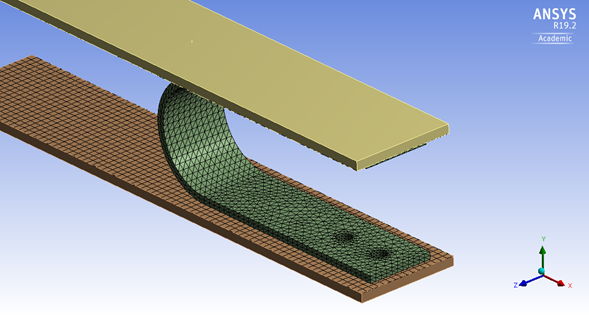TAGGED: force-convergence, force-criterion, multiple-nodes, nodes
-
-
June 3, 2021 at 3:08 pm
jorge_gonzalez
SubscriberHi, I was doing doing models of U-Shaped devices, as shown in the first picture. These have the same holes in the upper part, and in the surface of the upper holes I impose a displacement in Z or X direction (depending on the model) while in the surface of the lower holes I impose a fixed condition. The rectangular superior and inferior plates are rigid and are fixed, they are just to provide a restriction of movement to the U-Shaped element. The displacement imposed grows to 1 mm in the first second, 2 mm in the second and 60 mm in the third.
June 3, 2021 at 3:20 pmjorge_gonzalez
SubscriberI forgot to mention that the material is non-linear, with a bilinear curve
June 3, 2021 at 8:05 pmpeteroznewman
SubscriberIt will be better if you mesh the flexible member using a sweep method, sweeping across the thickness. It will be better if the mesh is linear elements and you put 8 elements along the sweep direction, through the thickness of the material.
Since the model is symmetric, it will be faster if you put a plane down the center of the model and slice the flexible body in half, and use a symmetric boundary condition.
It will be faster if you use edge sizing to use fewer elements across the width.
Viewing 2 reply threads- The topic ‘The Force Convergence Grapch doesn’t converge’ is closed to new replies.
Ansys Innovation SpaceTrending discussionsTop Contributors-
3597
-
1208
-
1092
-
1068
-
952
Top Rated Tags© 2025 Copyright ANSYS, Inc. All rights reserved.
Ansys does not support the usage of unauthorized Ansys software. Please visit www.ansys.com to obtain an official distribution.
-
The Ansys Learning Forum is a public forum. You are prohibited from providing (i) information that is confidential to You, your employer, or any third party, (ii) Personal Data or individually identifiable health information, (iii) any information that is U.S. Government Classified, Controlled Unclassified Information, International Traffic in Arms Regulators (ITAR) or Export Administration Regulators (EAR) controlled or otherwise have been determined by the United States Government or by a foreign government to require protection against unauthorized disclosure for reasons of national security, or (iv) topics or information restricted by the People's Republic of China data protection and privacy laws.












